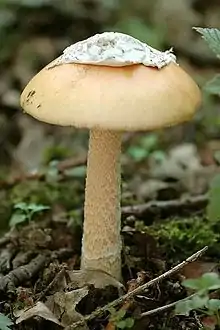Amanita frostiana
Amanita frostiana, also known as Frost's amanita, is a small fungus species of eastern U.S. and southeastern Canada.[1] The mushroom varies in colours from yellow, red or reddish pink usually.[3]
| Amanita frostiana | |
|---|---|
_Sacc_750397.jpg.webp) | |
| Scientific classification | |
| Kingdom: | Fungi |
| Division: | Basidiomycota |
| Class: | Agaricomycetes |
| Order: | Agaricales |
| Family: | Amanitaceae |
| Genus: | Amanita |
| Species: | A. frostiana |
| Binomial name | |
| Amanita frostiana (Peck) Saccardo | |
| Synonyms[1][2] | |
| |
| Amanita frostiana | |
|---|---|
float | |
| gills on hymenium | |
| cap is convex | |
| hymenium is free | |
| stipe has a ring | |
| spore print is white | |
| ecology is mycorrhizal | |
| edibility: not recommended or poisonous | |
Description
Some of the species' notable physical characteristics, however, distinguish it from the other members of the genus. For instance, the colors of the cap, darkening over the disk and the universal veil colored yellow to cream. The other characteristics of the other parts of its body are as follows:
- Cap : The cap is convex or sometimes shield-shaped, becoming flat with a fairly distinctly lined margin.[3] The cap may vary in lengths of 2-8 centimeters. The colors include yellow to golden orange or a different combination of scarlet or deep reddish pink. The surface is smooth, becoming slightly sticky when moist.[4]
- Stem/stipe : The stem, also called stipe. The universal veil material is yellow to cream, forming yellow powder or flakes at the base of the stalk. It measures 47 to 62 mm in length and 4 to 11 mm in diameter, also consisting a persistent annulus.[1]
- Gills : The gills are free, close, and cream in mass. The short gills are truncate to excavated-truncate and are numerous.
- Spores and microscopic features : The spores measure 7.0 to 10.2 µm wide and are globose to subglobose and inamyloid. It has also been noticed that the spores of this mushroom do not turn black in color if iodine is poured on it.[5]
Distribution and habitat
This rare species is normally found in mixed forests with oaks (mostly Quercus oaks) and conifers (mostly Pinaceae conifers).[1] It is considered native to eastern U.S. and southeastern Canada.[1]

Similar species
Amanita frostiana is similar to a range of species, like Amanita rubrovolvata, Amanita flavoconia, Amanita albocreata, Amanita muscaria var. muscaria or simply Amanita muscaria and Amanita subfrostiana.
Amanita rubrovolvata is slightly similar physically to this species. The fungus produces small- to medium-sized mushrooms, with reddish-orange caps. Roger Heim reported A. frostiana as occurring in Thailand,[6] but this was probably a misidentification of A. rubrovolvata.
Amanita subfrostiana, also referred to as 'False Frost's Amanita', has the same natural habitat as of A. frostiana, but is mostly distributed in southwestern China.[7] It does resemble A. frostiana but due to the different paleness of color in the cap of this species helps avoid misidentification.
The distinct and starkly white bulb (e.g., 17 x 15 mm) bears a white or yellow-white collar that is somewhat similar to the collar seen in the exannulate Amanita albocreata,[1] which is a species of the hardwood-hemlock (Tsuga) forest of the northeastern U.S. and southeastern Canada and of boreal forest at least as far north as the Island of Newfoundland.
The clamps present at bases of basidia of this species specially support the presumed relationship to Amanita muscaria var. muscaria or simply Amanita muscaria.[1] Amanita muscaria is a poisonous and psychoactive basidiomycete fungus, one of many in the genus Amanita.
Many misidentifications have taken place while recognizing Amanita flavoconia, one of the most common and widespread species of Amanita in eastern North America, due to various similar physical characteristics. It is mostly confused due to their microscopic features.[8]
See also
References
- R. E., Tulloss. "Amanita Frostiana (Peck)".
- "Amanita frostiana Peck, (1900)". Index Fungorum.
- "Amania frostiana". Rogers Mushrooms. Archived from the original on 2010-12-31. Retrieved 2011-03-15.
- S. Metzler, V. Metzler (1992). Texas mushrooms: a field guide (PDF). University of Texas Press. p. 331. ISBN 9780292751255.
- Shernoff L. "Amanita frostiana". The Connecticut-Westchester Mycological Association (COMA).
- Heim R. (1962). "Contribution à la flore mycologique de la Thaïland" (in French). Cite journal requires
|journal=(help) - R. E. Tulloss. "Amanita subfrostiana". Archived from the original on 2011-07-23. Retrieved 2011-03-16.
- R. E. Tulloss. "Amanita flavoconia G. F. Atk. var. flavoconia "American Yellow Dust Amanita"". Archived from the original on 2011-07-23. Retrieved 2011-03-16.
- Phillips, Roger (2010). Mushrooms and Other Fungi of North America. Buffalo, NY: Firefly Books. p. 17. ISBN 978-1-55407-651-2.
- United States. Dept. of Agriculture (1916). Bulletin of the U.S. Department of Agriculture. The Department. p. 57.
External links
| Wikispecies has information related to Amanita frostiana. |
